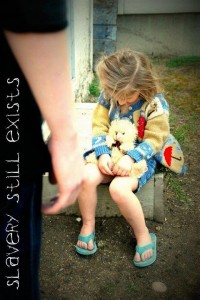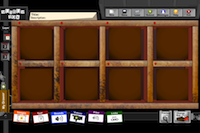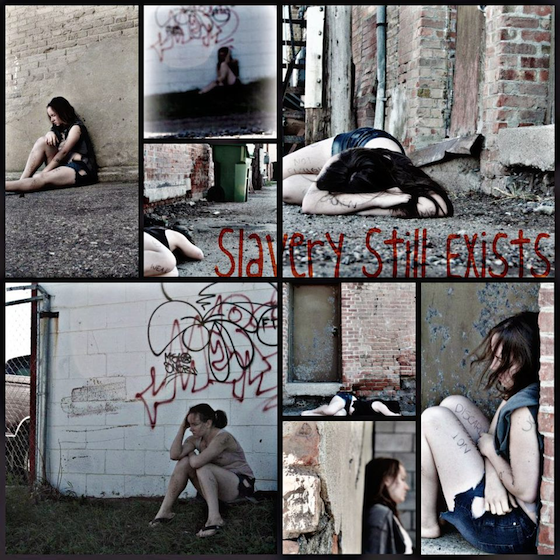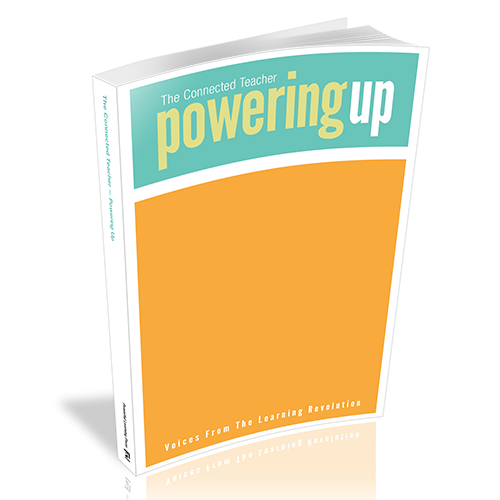I teach in an inquiry, project-based, technology embedded classroom. A mouthful, I know. So what does that mean? To begin with, I don’t lecture. My students don’t take notes, at least not in the traditional sense, and we don’t read a novel and simply answer the questions.
It means my classroom is a place where my students spend time piecing together what they have learned, critically evaluating its larger purpose, and reflecting on their own learning. It also means my students don’t acquire knowledge just for the sake of acquiring it. They need to do something with it — that’s where “project-based” comes into play.
Finally, technology is embedded into the structure of all we do. It’s part of how we research, how we capture information, and how we display our learning. It’s never an accessory tacked on at the end.
In my English classroom, this looks a lot different than in my biology & chemistry classrooms (which you can read about here). My English curriculum is largely skills-based, which provides a fair amount of flexibility. Many people ask me how I have the opportunities to do what I do in my classroom. My answer? It’s all in how you look at the curriculum.
Meeting curriculum and teaching goals
My curriculum states that I need to develop skills in 5 areas: reading, writing, viewing & representing, listening and speaking. The curriculum also suggests themes. Our grade 11 theme is childhood, but nowhere does it state whose childhood. So this year we read Patricia McCormick’s novel Sold, which chronicles the childhood, or more specifically the loss of childhood, in a young girl who is trafficked. A powerful story. This was the springboard into our unit on modern slavery and creating a social media campaign.
Whenever we begin a new inquiry unit, research is always involved. We start by sitting in a circle to talk through what we want, and need, to know about slavery in the contemporary world. From there the research begins. The first thing my students do is open a Google doc, access their Diigo or Delicious account, and sign into Symbaloo, a site that houses all of their favourite tools. We spend approximately one week on our initial research. Any more than this and students tend to become overwhelmed.
After researching, we come back together to discuss what needs to happen next. What is the best way to present our learning? What will be the most powerful? What do we want others to learn from us? Throughout this process, my students do most of the talking and leading. I tend to sit and listen, and at critical moments, draw out the nuances or similarities of what is being said. And when things aren’t working, sometimes I need to suggest a new direction.
Learning to use social media wisely
This semester, we’ve chosen to create a social media campaign to raise awareness around modern slavery. This is the project-based part. It’s not enough for my students to learn about slavery, they need to do something with it, specifically “real world” projects that matter.
 One of the most important things we can do is teach our students how to use social media wisely, and how social media can be used for social good. My students started by creating a Flickr feed, Facebook page, a YouTube account, a Tumblr blog, and a Twitter account.
One of the most important things we can do is teach our students how to use social media wisely, and how social media can be used for social good. My students started by creating a Flickr feed, Facebook page, a YouTube account, a Tumblr blog, and a Twitter account.
They decided that visual representations of their knowledge would be the most powerful. So some of my students created photographs depicting images that they felt best represented modern trafficking. These photos were then edited in Picnik, and posted to our blog.
Teaching this way also allows me to teach real writing to my students. Before we started to create videos, my students looked at numerous YouTube videos about slavery. They focused on those they found powerful, and conversely, those that weren’t very effective. We analyzed the differences between the two. My students talked animatedly about how the powerful videos touched your emotions.
I grabbed a piece of paper and drew a triangle. On each tip I wrote one of three words: Logos, Pathos, and Ethos. When you write for an audience, you can appeal to knowledge, emotion, or ethics — the Aristotelian triad. A few years ago I tried to teach this idea to a grade 12 class when we were studying essay writing. They didn’t get it. But in the context we were using, after comparing social media content, it made perfect sense to my grade 11 students. So we designed our videos with the triad in mind.
The hard work of creation
My students decided to create Common Craft-styled videos to educate viewers about slavery. These videos took hours. First, students needed to distill all of their “fact” knowledge into a compelling story. Then they needed to write the script, create paper characters, and finally begin to practice moving their papers on the whiteboard. My students soon discovered there is only a very small area to use on the whiteboard while filming these videos, otherwise you move out of view of the camera. In the end, it took hours to coordinate movement with script, film & then edit our videos. The remarkable thing is that these videos fulfilled many objectives across all 5 strands. Here’s one example:
As part of this project, my students have also Skyped into classrooms to teach what they have learned, so that other students can begin this enormously important discussion in their own communities. This is the connected part. My students believe that what they have learned is valuable, for themselves and for others too. They also believe they have a role to play in teaching others.
 My student are also creating a Museum Box, a project inspired by the work of Thomas Clarkson, who spent most of his adult life trying to abolish the trans-Atlantic slave trade. Clarkson carried a box to support his argument. The Museum Box site allows you to build an argument or description of an event, person or historical period by placing items in a virtual box. Students can display anything from a text file to a movie. My students will be using this platform to argue their thesis, rather than writing a traditional essay.
My student are also creating a Museum Box, a project inspired by the work of Thomas Clarkson, who spent most of his adult life trying to abolish the trans-Atlantic slave trade. Clarkson carried a box to support his argument. The Museum Box site allows you to build an argument or description of an event, person or historical period by placing items in a virtual box. Students can display anything from a text file to a movie. My students will be using this platform to argue their thesis, rather than writing a traditional essay.
For our second novel, we’re reading The Secret Life of Bees. For this unit, my students are engaged in wiki work. In pairs, my students are responsible for identifying the major themes in each chapter, and how they are developed. The first week I model this skill, and throughout the novel I coach my students as necessary. They’re also responsible for posting and responding to the discussion questions for each chapter.
How has this approach impacted my classroom?
My students have started designing our curriculum units. Seriously. While transitioning to our current unit, we discussed the possibilities as a class. Both Dr. Seuss & Christmas literature were mentioned as possible study topics. But one student wasn’t sold on either.
“Could we do something entirely different? Something that you haven’t done before?”
“Sure. What are you thinking?”
She thought and then said, “What about a movie unit? Could we study movies of different genres and then analyze them for themes and other different features? Is that possible?”
I explained that, with the English curriculum, we have more flexibility than with chemistry or biology. In those subjects, I’m specifically told what content I need to teach. In English, the concern is mostly around teaching skills, although the curriculum does stipulate how many novels, short stories, poems, etc. we need to include.
I further explained the five “strands” that we use in English and that there are multiple skill objectives for each strand.
“So yes, it’s possible to do something with movies.”
I asked them to talk a little bit more about what it might look like. My students brainstormed various possibilities. Maybe dividing into groups to show clips from various genres. Each group would be responsible to facilitate the discussion around the analysis. Maybe creating a digital space to post movie critiques, and other connected classrooms could join us. And, of course, there would be writing involved too.
After hearing a number of ideas, and seeing a plan beginning to formulate, one of my students looked at me and said, “Can you help us create a unit plan for this?”
Wow. Never in a million years did I think my students would ever say those words. Another student remarked, “Yeah, I only know how to teach swimming lessons.”
I looked at him and said, “Well, it’s not that much different.” When he gets in the pool he doesn’t just splash around for 30 minutes. He knows exactly what he’s going in there to accomplish. Not only that, he knows what it looks like when someone has mastered the skill and when someone isn’t even close. He agreed. Curriculum & teaching is pretty much that. We need to know what our outcomes are, the content we’re using to get there, and what we’re using to show our learning.
So I brought in the curriculum objectives…
 My students are always a bit surprised to see what curriculum actually looks like. They pulled out the objectives we are meeting with this unit. They chose six genres that they will look at with films as diverse as The Princess Bride, A Time to Kill, and Hitchcock’s North by Northwest. In groups they will analyze six elements in each film: themes, writing, character development, film techniques, setting and plot development.
My students are always a bit surprised to see what curriculum actually looks like. They pulled out the objectives we are meeting with this unit. They chose six genres that they will look at with films as diverse as The Princess Bride, A Time to Kill, and Hitchcock’s North by Northwest. In groups they will analyze six elements in each film: themes, writing, character development, film techniques, setting and plot development.
Once students have watched the film, they will meet with their group to discuss their findings. A group summary of their findings will be posted to the wiki. Students will also write a short analysis rating the film, including their basis for doing so. Ratings will be published to the wiki.
The next day, there will be an in-class discussion of the movie. Each group will contribute their observations. From the list of movies chosen, students will need to write a longer critique, much like an essay.
Students are excited about this unit because they designed it around something of interest to them. I’m excited about this unit because film is the medium of the future, and our students need to be astute at critically evaluating it.
My teaching . . . then and now
Before the technology/constructivist shift in my classsroom, I would have taught all of this quite traditionally. We’d read books, answer questions, and then address those questions in class. I’d lecture a lot, with supplemental grammar lessons here and there, and I’d include some type of artistic project to achieve viewing and representing objectives. The whole design would have been extremely teacher centered. And at the end of it all, I’d hope they learned something about writing and thinking.
Instead, inquiry and technology are a natural part of our English classes. It’s what my students have come to expect and have started to design themselves. Instead, of saying, “hand in your assignments,” I say, “publish your assignments and send me the link.” They think about connecting and sharing their learning in the larger world.
That’s the 21st century difference.
Images: Marissa Mellor (student), Museum Box, MGM
Shelley Wright
Latest posts by Shelley Wright (see all)
- Start with Why: The power of student-driven learning - May 8, 2019
- Are You Ready to Join the Slow Education Movement? - August 26, 2014
- Academic Teaching Doesn't Prepare Students for Life - November 7, 2013



Hey, Shelley.
Absolutely amazing post. There’s wonderful depth of detail in here about your process, as well as a real passion for learning that you are drawing out of your students. Rich title, wonderful focus, meaningful themes, student engagement, rationale and justification, a fine slate of social media tools, great media strategies/examples (love the common craft video, kudos to your students), and a super selection of movies the I’m sure any English teacher would love to see students working with. Truly impressive. I’m out of superlatives!
I’m wondering where you would suggest that folks begin in their journey along a similar direction? How many of the “pieces” need to occur concurrently, and which (if any) could precede the others? How to help folks make the process manageable and approachable if tackling “inquiry-driven, technology-embedded, connected, Less Teacher, More Student, Passion Based, 21st Century, Voiced, and Web Tools-That-Deepen-Learning-enabled” learning is a bit too much to tackle all at once?
Great work! Looking forward to hearing more! 😉
Great question, Andy! I certainly didn’t start like this! My classroom, at this point, is the culmination of a years work.
I would suggest starting with one unit, in one class and shifting to an inquiry focus. Allow students to explore what matters to them. They may not even know at first. When my students first started learning like this, they weren’t sure what to do. I show a few videos like the common craft explanation of project-based learning and Chris Lehmann’s TED X video. It’s important for students to learn why the shift in learning is significant to them.
During this process, you can slowly begin to embed technology. Embedded tech, like Google docs or Diigo, become second nature to students quite quickly. My students automatically open both when working.
The one thing you don’t want to do is too much too soon. It might be overwhelming for the teacher & students! As my students have become more competent and self-directive we add new tools, like the museum box. I tend to add new things when it comes to the “show your learning” stage.
It’s a year into our inquiry, tech experience and we’re just beginning to connect with others. I think the importanat thing to remember is that this is a journey for both teachers and students — one they should enjoy!
Thank you for this post. It is inspirational. There are lots of project based learning things out there but I think your post captures the essence so beautifully.
Now I just dream of the day when learning like this is the norm not the exception.
Thanks, Melissa! Me too!
Today conventional teaching got a set back.Now students need something new in this process. For the outcome of innovative and creative ideas they demand changes in the education process indeed. Thanks.
I knew there was something about the writing (and teaching) I saw coming from you every so often. English and Science, eh? There’s something about that combination that really allows a person to see strands between content, ideas, ways of thinking, etc.
My wife (@erinlynnnash) is actually an English major/ Biology minor, certified in both and a Science Department head of her high school. We’ve always had a ton in common when planning, reflecting, or debating an approach to use in the classroom. I’m betting we’d all get along famously. 😉
You can read more about Shelley’s teaching journey by clicking on her name at the top of this blog post. That will pull up her past posts, where you’ll find plenty of transparency.
John
VFLR editor
Hi there, Shelley.
Thanks a lot for sharing your experiences! It is inspiring to read about your projects as they are obviously great examples of how to combine not just technology, but perhaps more importantly, meaningful existential issues to the teaching of the 5 skills. I´m impressed. I would have loved to visit your classroom, as you seem to have found a way to capitalize on the net-culture, avoiding the many pitfalls experienced by so many at this day and age. One serious problem we find it hard to cope with, is the sheer time spent off-task, or simply on technology (not subject matter..) when introducing technology in the classroom. What are your experiences? How do you deal with less inspiring topics, such as grammar? I can tell that your students´get much more from their learning experiences than just the five skills, but how do they compare with similar classes in terms of the five skills? Again, thanks for the post!
Thomas
Thanks for writing, Thomas! I have to admit,when my students first started learning tech tools, it took a fair amount of time. Now that my students are so used to it, it’s not even noticeable.
I think part of it depends on grade. My students are grade 10-12. The other part of it is seeing the time as a long term investment. Students soon get over the thrill of new tech, and become excited about the things they can do WITH it. So I encourage you to hang in there.
Sometimes it might mean laying down some pretty strict rules around how tech can be used.
From what I can tell, my students do as well, or better, than students in a traditional classroom. We don’t have a lot of standardized testing, but from the exams we do write, most of my students are well above average. I think it’s likely because we develop a lot of problem solving skills.
I must agree that your description is inspirational and getting me to think of new ways to do inquiry-driven lessons. I’ve actually had students create paper slide videos (ala Common Craft) about the compromises leading to the American Civil War, and this year I used Museum Box for a unit on Africa in my World Cultures class.
My challenge is still at a more basic level — how to incorporate technology on a daily basis when we’re still in a computer lab-based environment, and the lab is often booked for a daily class during the period that I teach a class. We have a laptop cart, and I’ve used those, but that has its own challenges. The biggest challenge, though, is still the predominance of fear of the Internet — YouTube, Facebook and all other types of social media are blocked at my school. I can work around them with a teacher login, but that’s not viable for multiple students.
Just wondering how to get to inquiry-driven, project-based, when technology at our school is not yet “like oxygen: necessary, ubiquitous and free” as Chris Lehman (from my hometown) says.
You raise a great question, Bill. My school environment sounds a lot like yours. Our computer access is limited to a computer lab or a portable Mac lab, which we have so many problems with that my students hate to use it. So I do run into problems accessing tech, at times. I really can’t see us being a 1:1 class anytime in the near future! But I think it’s still possible to do a lot of great things, even without it.
In our day-to-day classes, we tend to use the tech my students have on them, a few laptops & smart phones. Maybe an ipad or two. For us, this has worked the best. It’s organic & presents the fewest problems.
We are allowed to use social media, however. The division I work for is fairly progressive in this area. Have you tried something like teachertube? Or downloading the videos?
I think the most important thing teachers in your area can do is lobby for the use of social media and educate around its importance.
Thank you so much Shelley for sharing with us truly purposeful learning experiences. Oh, to be a student in your class! It is inspiring to see examples of web2.0 technologies that are mindfully integrated into the curriculum as the ‘third teacher’. Please keep inspiring us!
Thanks, Daniel!
Wow. Fabulous explanation of the work you and your students compose. Thank you.
What makes this kind of “creation” different/better than a classic book report?
Shelley,
What an outstanding articulation of what teaching can and should be. I hope your students know how much they are getting that they would not get in so many other classrooms.
I don’t have the time to write a full comment or response; I have been thinking and working on what you are doing for the better part of 30 years, so a quick stab would be just that. And I hate to self-promote (don’t usually do this) but you would really enjoy a book I wrote a few years ago after teaching in much the same way you are. Believe me, I did not write it to make money (proceeds go to our scholarship fund), but I really think you might enjoy it. It is titled The Falconer; you can get it on Amazon. Would love to hear any feedback and how it might contribute to your great methodology. Have seen it used effectively from 4th grade to Middle School to High School and in college level, so hopefully it might hold something for you!
Thanks, Grant! Sounds like the perfect read for Christmas break.
Shelley
Your post is mind blowing. Reading through it was like being on the F1 track, just one thing after the other, adrenalin pumping in really. For any teacher who is struggling finding directions for where to begin, this is the ‘key’. Thank you for your honesty and transparency. It will go a long way into building tech driven classrooms across the globe. You have lit the fire……..
Thanks for your words of encouragement! I appreciate them 🙂
Shelley,
Hopefully so; it is not a cookbook, and there are some stories that run through it so hopefully something you can curl up with. Would love comments when and if you get to it. Regards,
Shelley this post is one of the best I have read on the topic. I have been working with numerous other education experts on developing a curriculum much like you describe above. The aspects of student ownership and collaborative, project-based learning are exactly what the education systems need.
I commend you on your innovation, creativity, and courage to implement such a system in your classroom. I would love an opportunity to speak with you if you have the time. (I think this post will send you a private email with my email attached).
Outside of that conversation, have other teacher’s in the school began to implement some of the same approaches and techniques? Do you feel the students will begin to demand this type of approach from all teachers? (I think everyone can benefit from reading the answers to those questions)
Great post again and I look forward to you contacting me!
Over the past year, I have seen slow change, mostly because my student’s are beginning to ask for what they need. I think that’s one of the most exciting things about teaching students that they are responsible for their own education.
For the most part, the school I’m at is still pretty traditional. For students who have me for only one class, it can be like walking into, and out of, a different world.
Some find that difficult and begin asking their teachers for changes.
One of the things I wonder about is students who graduate and head off to university, only to encounter a rather archaic lecture system of teaching. What will happen then?
Well, Shelly..as I have returned to college for my 2nd career and found this website preparing for my student teaching assignment, I have to tell you….college is still archaic. And so am I, but some profs are really bad! But until these kids go to college and expect more, what can anyone expect. I for one learned this way best and that was many moons ago. I can’t wait to read more and teach more this way! My family has even said recently that they now see why I want to teach–I’m excited to give back after a very successful business career. But, I don’t want to lecture, I want them to learn through experience!
I’m excited that you’re going to be entering the profession. Kids need teachers who understand the importance of learning through experience.
And I completely agree with your assessement of college. It is archaic, and until students demand more, it will stay that way. Thanks for sharing!